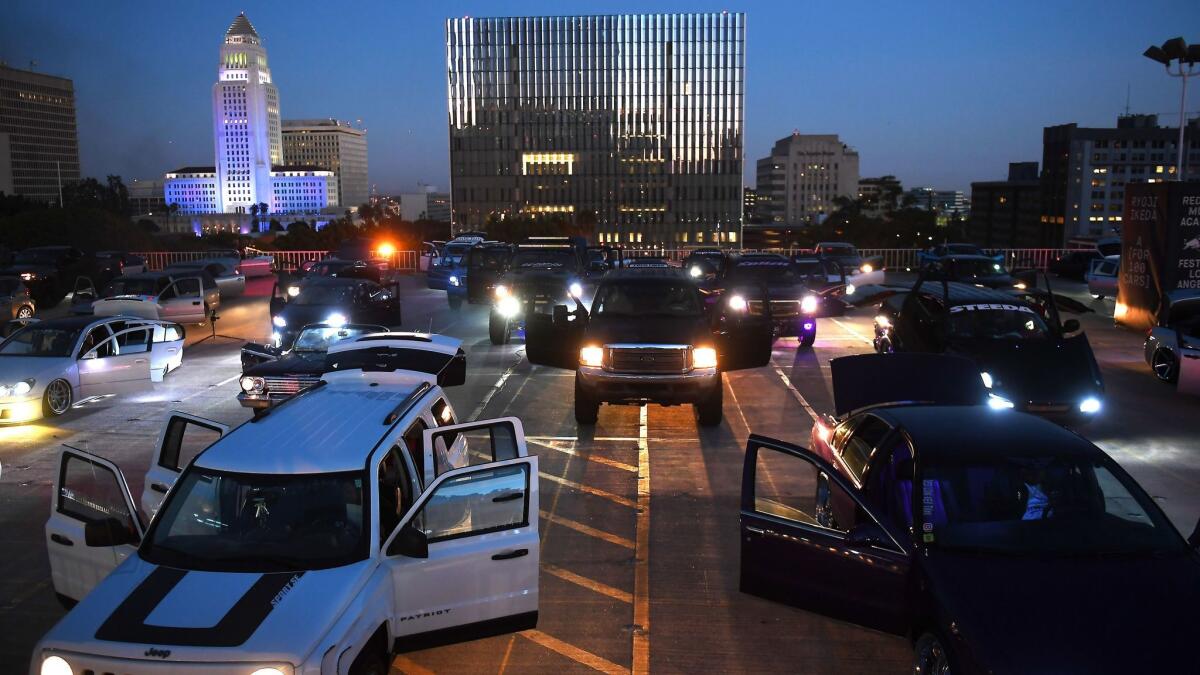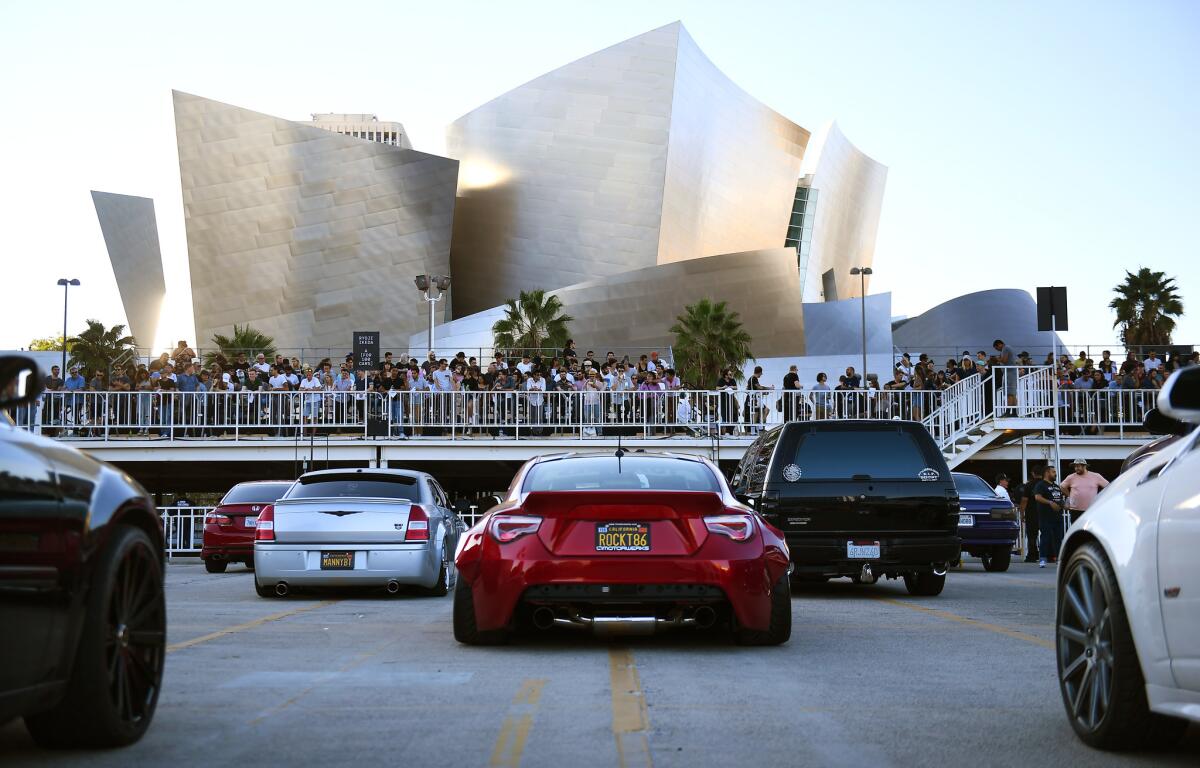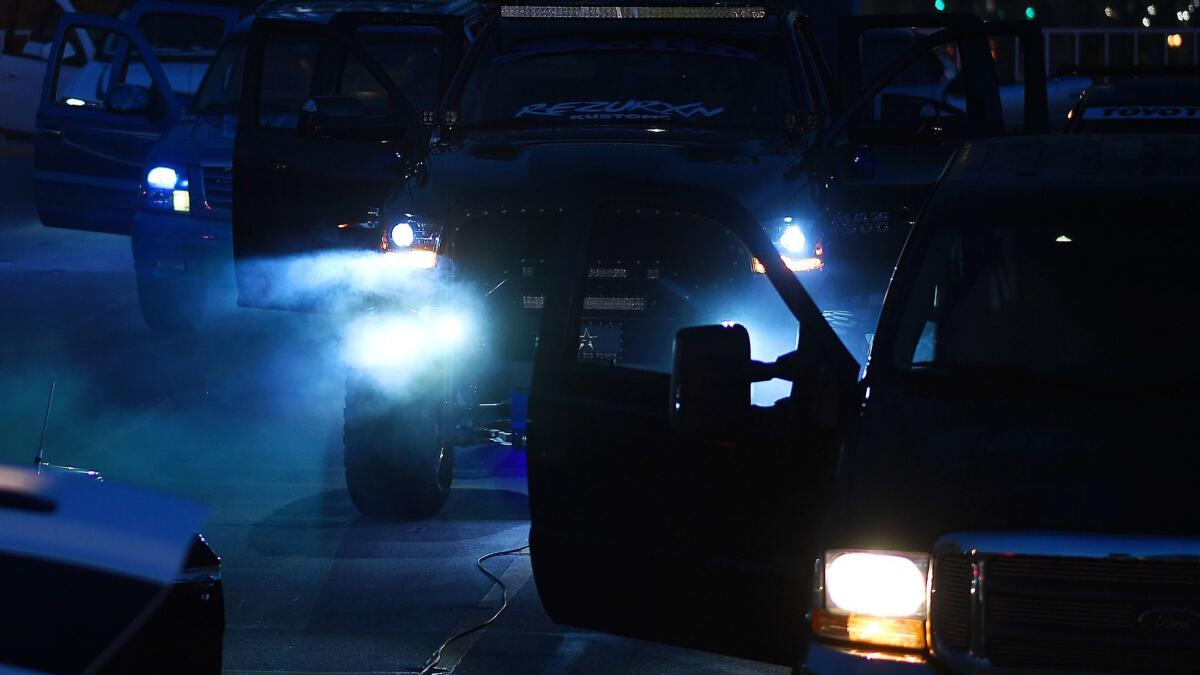Hear the sound of 100 lowriders, drifting cars and souped-up auto stereos jamming a single note — courtesy of composer Ryoji Ikeda

On Sunday at dusk, about 100 car enthusiasts from across the region walked onto the roof of a downtown parking garage just east of Walt Disney Concert Hall and fanned out toward their vehicles.
Parked neatly in rows with ample room between, the various machines were chosen by Japanese visual and sound artist Ryoji Ikeda for a single trait: their stereo sound systems, which he would harness in service of a composition called “A [for 100 Cars].”
Remarkable machines, part of the region’s obsession with car culture, carried them: a shimmering late-model Corvette, painted as if molded from a gold bar; a finely detailed blue Chevy Impala, circa mid-1960s, its bumper mere centimeters from the ground; and a mid-1970s Lincoln Continental lowrider, all rectangles and 90-degree angles, named the Baby.

Gathered by Ikeda as part of the month-long Red Bull Music Academy Festival Los Angeles, which features a wild array of musical happenings spread across the metro area, the cars ranged from classic lowriders to drift-style Japanese mini-coupes to otherwise nondescript Ford SUVs. Their defining trait was an ability to emanate bolt-loosening bass and crisp, clear A notes.
Ikeda, a minimalist composer whose thoughtful work starting in the mid-1990s has explored the mechanics of tones, clicks and bleeps and the ways in which sound registers and is defined, envisioned this project six months ago.
They wouldn’t all be playing the same A, though. Rather, as Ikeda explained during a conversation after the performance, over the centuries the precise pitch of that note has varied, and he set each car to be aligned with this range of A notes.
The tone from a late-model white Cadillac SUV, upon whose hood was airbrushed a painting of three scantily-clad models, generated an A at 457.2 hertz, as defined by an 1879 tuning fork used by Steinway & Sons piano makers.
The stereo in a buzzing Honda Civic, outfitted for drifting à la “The Fast and the Furious,” played the A as understood by the Paris Grand Opera in 1811 (427 hertz). Others played notes referencing a Spanish cathedral or a tuning fork made by inventor John Shore.
Although Ikeda was in attendance, the publicity-shy artist didn’t need to conduct the piece in real time. He’d outfitted the cars with self-designed cassette-sized synthesizers. With each set to the proper pitch, the drivers were directed to switch a knob at timed intervals, at which point the various A notes would shift octaves.
When the 100 or so drivers and passengers got into their cars and ignited and revved those engines to announce the beginning of the performance, the harmonic rumble suggested symphonic musicians tuning before a concert — except with way more exhaust fumes.
At 6:17 p.m. as the sun set behind Disney Hall, a resonant, upper octave A seeped into the environment. The thousand or so attendees grew silent, watching in bleachers overlooking the idling cars and hearing a note that, although crisp and clear, varied from spot to spot as cars produced slightly unaligned tones.
Heard from Little Tokyo a few blocks away, the combined frequencies might have sounded like an alien encounter. From 50 yards, the note seemed to drift in like a breeze. Lacking beats, melody or forward momentum, it hung in the open air like a flock of hummingbirds hovering around a feeder.
After a few overwhelming minutes, drivers started switching their knobs to the next setting, and a waft of sound waves shifted the environment — the same note but at a varied register. Then lower, producing a bass-level A that made the garage beams hum.

The performance, which lasted about 25 minutes, felt like a feat not only of bringing imagination to life, but of organization and community. Though a defining part of L.A. culture, car clubs can be insular worlds, with lowriders, drifting racers and car audio obsessives leading parallel existences on the same Southern California roads.
In a makeshift green room afterward, Ikeda was quick to deflect praise, calling the project “a collaboration between me and all these drivers — the local communities — and also the big chief here, Red Bull, and all the technicians.”
In choppy English, he said that the undertaking was a bit overwhelming, but “so special, because no one knows how to handle it before. No one did this before.”
Adding that he was struck by the openness of the car club members, Ikeda said he traveled to Southern California last month to meet with leaders “to discuss face to face [the project], and we became friends. Then we understand each other.”
He noted that he was proud to help breach the insularity among the various communities, explaining that the lowriders and drifting drivers tended to socialize among themselves.
Lowrider enthusiast and clothing brand owner Lala Romero came out to “see something that we’ve never seen before,” she said before the performance.
Echoing Ikeda’s experience, she said, “It’s so cool to see so many different types of cars, especially if you’re from one scene. We just know about lowriding, but to now get to see everyone else come together and figure out how this is sonically going to make sense will be really cool.”
Ikeda said that he’ll carry that sense of community with him, as well. “If I didn’t have this project I would never meet this group in my life. More than the art project, this is really meaningful for myself.”
Sean Kerr, owner of a red 1964-and-a-half Ford Mustang (the first-ever model), described the event as “an eye-opening experience” after it was over. “I’m used to hip-hop culture, but we participated and it was very interesting, hearing the combination of unique sounds — bass, high-pitches and different frequencies.”
Jamaar Simon expected something different: “When I think of an orchestra, I’m like, OK there’s a horn section, and then cellos and a [string] section, and that maybe we were going to be our own instruments.”
Still, he recalled the performance as “completely different than anything else I’ve experienced in my life.”
The A that sprang from his pristine yellow and black 1970 Buick GSX was set to 422.7 hertz, the pitch of which, Ikeda wrote in performance literature, was sourced from a 17th-century tuning fork that belonged to the Broadwood piano makers of London.
Courtesy, that is, of General Motors.
For tips, records, snapshots and stories on Los Angeles music culture, follow
The biggest entertainment stories
Get our big stories about Hollywood, film, television, music, arts, culture and more right in your inbox as soon as they publish.
You may occasionally receive promotional content from the Los Angeles Times.




